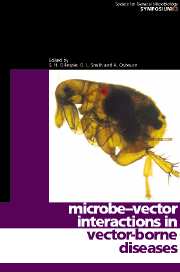Book contents
- Frontmatter
- Contents
- Contributors
- Editors' Preface
- 1 Vector-borne diseases
- 2 Evolution of tick-borne disease systems
- 3 Insect transmission of viruses
- 4 RNA-based immunity in insects
- 5 Specificity of Borrelia–tick vector relationships
- 6 Bunyavirus/mosquito interactions
- 7 How do mosquito vectors live with their viruses?
- 9 Vector competence
- 9 Environmental influences on arbovirus infections and vectors
- 10 Vector immunity
- 11 Transmission of plant viruses by nematodes
- 12 Wolbachia host–symbiont interactions
- 13 Pathogenic strategies of Anaplasma phagocytophilum, a unique bacterium that colonizes neutrophils
- 14 Interactions of Yersinia pestis with its flea vector that lead to the transmission of plague
- 15 Transgenic malaria
- 16 Vaccines targeting vectors
- Index
2 - Evolution of tick-borne disease systems
Published online by Cambridge University Press: 06 July 2010
- Frontmatter
- Contents
- Contributors
- Editors' Preface
- 1 Vector-borne diseases
- 2 Evolution of tick-borne disease systems
- 3 Insect transmission of viruses
- 4 RNA-based immunity in insects
- 5 Specificity of Borrelia–tick vector relationships
- 6 Bunyavirus/mosquito interactions
- 7 How do mosquito vectors live with their viruses?
- 9 Vector competence
- 9 Environmental influences on arbovirus infections and vectors
- 10 Vector immunity
- 11 Transmission of plant viruses by nematodes
- 12 Wolbachia host–symbiont interactions
- 13 Pathogenic strategies of Anaplasma phagocytophilum, a unique bacterium that colonizes neutrophils
- 14 Interactions of Yersinia pestis with its flea vector that lead to the transmission of plague
- 15 Transgenic malaria
- 16 Vaccines targeting vectors
- Index
Summary
INTRODUCTION – BIOLOGICAL CONSTRAINTS ON PATHOGENS’ USE OF TICKS AS VECTORS
All vector-borne disease systems involve a triangle of dynamic reciprocal interactions between vector, host and pathogen, which is subject to two major classes of constraints. The intrinsic physical, physiological, cellular barriers determine whether the route of transmission is possible. The pathogen must be adapted to invade, establish and survive in vertebrate and invertebrate tissues alternately, and is also at the mercy of the vector–host interaction upon which depends the passage of fluids (typically vertebrate blood and invertebrate saliva) as a vehicle for infective particles. Transmission is not simply a mechanical matter, but rather a biological process whose complexity at the cellular and molecular level is still the focus of much research aimed at developing blocking agents. These biological barriers, which constitute the innate immunity of host and vector, are not absolute, but become more or less leaky through slow evolutionary change. By comparison, the second class of constraints, ecological and epidemiological hurdles, may change much more rapidly. They depend on the quantitative balance between all the factors determining the rates of transmission: transmission may be biologically possible but may not always occur effectively enough to allow persistent cycles of transmission. Such hurdles are determined to a large extent by the impact of extrinsic multifactorial environmental factors on the vector–host–pathogen triangle, and also by the impact of intrinsic factors such as host acquired immunity.
In this essay, I suggest that the evolution of tick-borne pathogens is driven by intrinsic biological barriers, but is directed and constrained by extrinsic environmental factors.
- Type
- Chapter
- Information
- Microbe-vector Interactions in Vector-borne Diseases , pp. 19 - 42Publisher: Cambridge University PressPrint publication year: 2004
- 1
- Cited by



